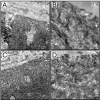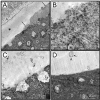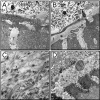Ethanol wet-bonding challenges current anti-degradation strategy
- PMID: 20940353
- PMCID: PMC3144072
- DOI: 10.1177/0022034510385240
Ethanol wet-bonding challenges current anti-degradation strategy
Abstract
The long-term effectiveness of chlorhexidine as a matrix metalloproteinase (MMP) inhibitor may be compromised when water is incompletely removed during dentin bonding. This study challenged this anti-bond degradation strategy by testing the null hypothesis that wet-bonding with water or ethanol has no effect on the effectiveness of chlorhexidine in preventing hybrid layer degradation over an 18-month period. Acid-etched dentin was bonded under pulpal pressure simulation with Scotchbond MP and Single Bond 2, with water wet-bonding or with a hydrophobic adhesive with ethanol wet-bonding, with or without pre-treatment with chlorhexidine diacetate (CHD). Resin-dentin beams were prepared for bond strength and TEM evaluation after 24 hrs and after aging in artificial saliva for 9 and 18 mos. Bonds made to ethanol-saturated dentin did not change over time with preservation of hybrid layer integrity. Bonds made to CHD pre-treated acid-etched dentin with commercial adhesives with water wet-bonding were preserved after 9 mos but not after 18 mos, with severe hybrid layer degradation. The results led to rejection of the null hypothesis and highlight the concept of biomimetic water replacement from the collagen intrafibrillar compartments as the ultimate goal in extending the longevity of resin-dentin bonds.
Figures



Similar articles
-
Ethanol-wet bonding and chlorhexidine improve resin-dentin bond durability: quantitative analysis using raman spectroscopy.J Adhes Dent. 2014 Oct;16(5):441-50. doi: 10.3290/j.jad.a32695. J Adhes Dent. 2014. PMID: 25202747
-
Effect of chlorhexidine incorporation into dental adhesive resin on durability of resin-dentin bond.J Adhes Dent. 2012 Aug;14(4):355-62. doi: 10.3290/j.jad.a25674. J Adhes Dent. 2012. PMID: 22518385
-
Adjunctive application of chlorhexidine and ethanol-wet bonding on durability of bonds to sound and caries-affected dentine.J Dent. 2014 Jun;42(6):709-19. doi: 10.1016/j.jdent.2014.04.001. Epub 2014 Apr 13. J Dent. 2014. PMID: 24732576
-
From dry bonding to water-wet bonding to ethanol-wet bonding. A review of the interactions between dentin matrix and solvated resins using a macromodel of the hybrid layer.Am J Dent. 2007 Feb;20(1):7-20. Am J Dent. 2007. PMID: 17380802 Review.
-
Limitations in bonding to dentin and experimental strategies to prevent bond degradation.J Dent Res. 2011 Aug;90(8):953-68. doi: 10.1177/0022034510391799. Epub 2011 Jan 10. J Dent Res. 2011. PMID: 21220360 Free PMC article. Review.
Cited by
-
MMP Inhibitors and Dentin Bonding: Systematic Review and Meta-Analysis.Int J Dent. 2021 May 27;2021:9949699. doi: 10.1155/2021/9949699. eCollection 2021. Int J Dent. 2021. PMID: 34135969 Free PMC article. Review.
-
Inhibition of endogenous human dentin MMPs by Gluma.Dent Mater. 2014 Jul;30(7):752-8. doi: 10.1016/j.dental.2014.04.006. Epub 2014 May 17. Dent Mater. 2014. PMID: 24846803 Free PMC article.
-
Mechanisms regulating the degradation of dentin matrices by endogenous dentin proteases and their role in dental adhesion. A review.Am J Dent. 2014 Aug;27(4):203-14. Am J Dent. 2014. PMID: 25831604 Free PMC article. Review.
-
Impact of Dentine Pretreatment with Matrix Metalloproteinase Inhibitors on Bond Strength of Coronal Composite Restorations: A Systematic Review and Meta-analysis of In Vitro Studies.Eur J Dent. 2023 Oct;17(4):974-999. doi: 10.1055/s-0042-1757582. Epub 2022 Nov 18. Eur J Dent. 2023. PMID: 36400108 Free PMC article.
-
High-Performance Dental Adhesives Containing an Ether-Based Monomer.J Dent Res. 2020 Feb;99(2):189-195. doi: 10.1177/0022034519895269. Epub 2019 Dec 20. J Dent Res. 2020. PMID: 31861961 Free PMC article.
References
-
- Becker TD, Agee KA, Joyce AP, Rueggeberg FA, Borke JL, Waller JL, et al. (2007). Infiltration/evaporation-induced shrinkage of demineralized dentin by solvated model adhesives. J Biomed Mater Res B Appl Biomater 80:156-165 - PubMed
-
- Blackburn RS, Harvey A, Kettle LL, Manian AP, Payne JD, Russell SJ. (2007). Sorption of chlorhexidine on cellulose: mechanism of binding and molecular recognition. J Phys Chem B 111:8775-8784 - PubMed
-
- Cameron IL, Short NJ, Fullerton GD. (2007). Verification of simple hydration/dehydration methods to characterize multiple water compartments on tendon type 1 collagen. Cell Biol Int 31:531-539 - PubMed
Publication types
MeSH terms
Substances
Grants and funding
LinkOut - more resources
Full Text Sources

